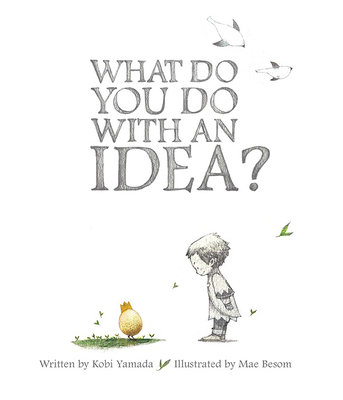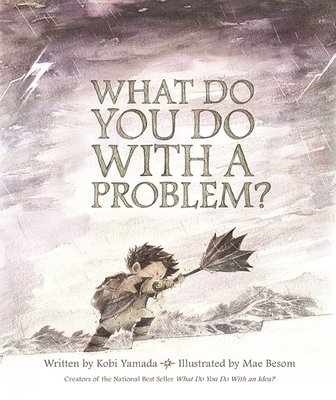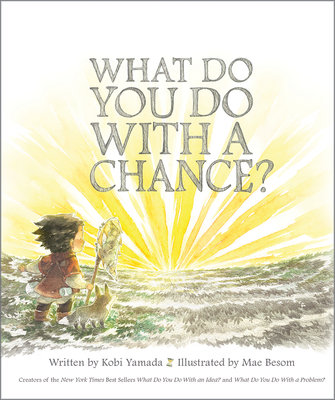Kobi Yamada on Embracing Our Ideas and the Chances That Come Our Way
by Kathryn Haydon
Kobi Yamada is the author of many inspirational books published by Compendium, where he has worked for 25 years, three quarters of that time as CEO. But his most recent trio of picture books has taken the New York Times bestseller list by storm. What Do You Do With an Idea?, What Do You Do With a Problem?, and the latest, What Do You Do With a Chance?, make the sometimes uncomfortable creative process come alive so we can examine it from all angles. In all three books, whimsical illustrations are integral to the story. Illustrator Mae Besom plays with light, color, and design, lending the stories even deeper meaning.
In What Do You Do With an Idea? we are introduced to a child who has an idea but isn’t sure what to do with it. Initially intimidated, the idea grows on him and, quite literally, becomes his friend. As he cares for it, the idea blossoms and goes on to change the world.
This book tackles the resistance that the world generally has to new ideas; it shows that we can push past our own doubts and criticism from others when we hold onto our ideas with conviction. If we can allow ideas to be born and nurture them a bit before judging them, we give them the opportunity to become great.
What Do You Do With a Problem? highlights the fear that arises when we face problems. The story begins in black and white as the child is mentally pursued by his worry. When he decides to face his fear and tackle the problem, he finds a beautiful opportunity inside it. The lesson is that within every problem is a possible opportunity if we are willing to look for it.
Fundamentally, this book is an introduction to the importance of creative thinking. When we are practiced in our abilities to think creatively — to think up new ideas — we have more freedom and flexibility. When problems present themselves, we know we can apply our creative thinking to find many solutions.
What Do You Do With a Chance? is set to be released this month. Taking the opposite approach to What Do You Do With a Problem?, the child is immediately presented with a golden opportunity. Keeping with the arc of the series, he initially rejects it but gains courage as the narrative and images unfold. His fear is replaced by hope; with this expectation of good, the chance presents itself once again. This time, he jumps right in!
Once again, the book touches upon one of the most important drivers of creativity: openness to experience. The lesson of this book is seen clearly in Kobi’s inside-cover dedication to his kids: “When something extraordinary shows up in your life, I hope you see it for what it is . . . a gift.” In other words, stay open.
I interviewed Kobi ahead of the release of What Do You Do With a Chance? and his insights were as inspiring as his books.
What are your favorite stories about how your books have inspired kids or parents?
When What Do You Do With an Idea? came out, I received a call from the Tanner Dance School in Salt Lake City. They had reinterpreted the book into a dance performance. It was so inspiring for me to see this because it illustrates one of the points of the book — that ideas can build on ideas.
Many kids have become empowered by reading the books because they help them see that their talents and voices are important to the world. A young guy in California took on saving endangered frogs after he read What Do You Do With an Idea? Kids are revisiting the concept that they matter.
What do you hope that your books will help accomplish in the world?
What happens if we get millions of kids to believe in their own ideas and to collaborate with other people’s ideas?
What Do You Do With an Idea? is being made into an animated short film. Does this represent a special “chance” for your book’s message?
Yes! We are working with Film Roman and it is gorgeous to see in the movie that what we are really talking about is creativity. You can see what your idea can do for the world, for you, and how much more fun life is with your idea around. We want kids to be able to move from having an idea in their heads to having it in their hearts. When you love something, you protect it.
It’s cool to see the quality of people lining up to create this film. Making the movie is like seeing something familiar be born anew. It’s as if we’ve taken the book, magically split it open, and put onto the screen what is in your imagination as you turn from page to page. The film allows us to step into the space where imagination meets real life.
One of the important aspects of your books are the way the light and color of the illustrations integrate with the narrative. I noticed in What Do You Do With a Chance? that the chance that presented itself to the child was exquisitely colored, right from the beginning. What inspired that?
It was purposeful that the illustration of the chance incorporates light. Chances are sparkly, beautiful things and you don’t get to pick when they arrive; they are sparkles that just come to you and you have to be ready. My 12-year-old daughter asked me after I wrote the book, “Dad, do you know why we like sparkles? It comes from looking for water in the desert. Water would catch our eye because we needed it to catch our eye because we need it to live.”
I didn’t know that but when we created What Do You Do With a Chance? the philosophy was similar. We wanted the chance to feel special and sparkly — something that has a little illumination to it. When the child is turning back toward inner fears and doubts, the illustration of the chance starts fading to the point where it doesn’t come around anymore. We have to stay open and ready to take the chances that come to us because we don’t necessarily get those opportunities ever again.
My family went to Japan a couple of times this year and learned about the Japanese idiom ichi-go ichi-e. It’s about treasuring the present moment spent with others and is traditionally associated with tea ceremonies. Each meeting with another person or group of people is sacred, and we have to honor the sacredness of each unique moment. If you position a concept like this with What Do You Do With a Chance? you realize that everything is a once-in-a-lifetime experience. It would be great if we could get kids to embrace the preciousness of the moment. There are so many things these days that take us out of the now. It’s a constant conversation to figure out how to be alone with your thoughts and even experience boredom which is important to creativity.
What’s your definition of creativity?
Creativity is very personal and one of most valuable commodities that we have. It is part art and part science. Many times you feel like a vessel so lucky to receive these ideas, insights, concepts and that it is your responsibility to do something with them. One of the reasons I made the idea “character” into a plush toy is that I wanted kids to feel that their own creativity, their own ideas can be like friends.
In What Do You Do With an Idea? the idea character already knows it has value. The idea itself has the inertia that the child doesn’t have. It helps the child to see its worth and value. I tend to think that way about creativity. It’s a big honor, a beautiful gift you can give to the world. How do we set ourselves up to have great ideas? There are many ways, but we have to be open to them when they come.
Do you have any new writing projects?
Yes, I have already written my next book and it’s a whole new adventure. But for now, it’s a secret.
-
Books Mentioned in This Article
-
Have you read Kobi’s books, and if so, how have they helped you, or your children, gain confidence in your own ideas and creativity?



